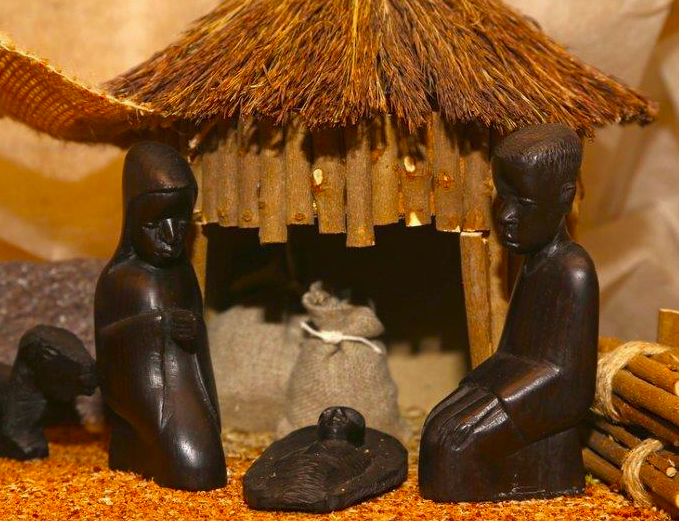Christmas in Burkina Faso
Christmas in Burkina Faso: nativity contest and interreligious dialogue with the sound of forks in a festive atmosphere.

Like most of the world, Christmas in Burkina-Faso is synonymous with joy, prayers and celebrations of and for children.
A Christmas crib contest
In many families, children are boldly building Christmas cribs. These are generally built with bare hands from earth or clay, collected in an anarchic way by the children in their neighborhood. To this basic material, straw is sometimes added, which gives the nativity scenes a traditional and authentic aspect. On the other hand, they are cans of sardines that are recycled to serve as molds for the manufacture of mini-bricks. And depending on the case, we can see statuettes of the little Jesus and his parents enthroned in the center of the crib.
All sorts of decorations give the works that festive look so sought after. For the lucky ones, they even managed to get paint, garlands or lights to make their building shine.
Everywhere in Burkina, the youngest are passionate about this recreational activity, which is also the subject of fierce competition. The children compete with each other to create the most beautiful crib in the neighborhood. A television channel even had the idea of rewarding each year the three most beautiful works following a contest. It travels to all the neighborhoods of Ouagadougou to find the rare pearls.
A matter of community solidarity
Here, the community is understood as the one constituted by the neighborhood in the residential areas. Its members are linked by geographical proximity which induces relationships of rights and duties agreed upon and nourished by numerous rituals, among which the sharing of meals during religious holidays.
In fact, in Burkina, the celebration of Christmas also resonates with the spirit of solidarity, sharing and generosity between members, not only of the same family, but also of the same neighborhood.
As soon as the sun rises to its zenith, a ritual, eagerly awaited by some and staged by others, begins: the round of dishes.
It is a joyful ballad of meals cooked for the occasion by each family of Christian faith. They then entrust their children with the mission of offering this dish, carefully garnished, to neighboring Muslim families.
Most often, these dishes are placed on the heads of the children on a cloth, as a trivet. Then it is up to the children to play their role of ambassadors. We see them in groups of two or three in single file in front of their neighbors' doors. They don't have to open their mouths before a member of the beneficiary family comes to meet them to get rid of their victuals. The ritual continues with the transfer of the food and the immediate return of the empty dishes. Everyone knows that the same dish will be used for the next family's service, so it must be done quickly. But as a matter of principle, the empty dishes will be returned without being cleaned, that's how it is! Indeed, there is a belief that surrounds this form of prohibition.
The protocol finally ends with thanks and good wishes, which the ambassadors will be invited to transmit to their parents.
Just back home, and already in the kitchen the next giant steaming ladles are ready and will fill again the dishes with sauces and tasty pieces of meat (beef, chicken, guinea fowl). Immediately the mother loads the children and it's off again!
The area covered by this distribution is the area composed of the Muslim neighbors around the house: those with whom one shares a common wall on all four sides, those across the road, and those who are further away (or even from another neighborhood) but with whom one shares a special relationship. This can represent about six different families.
A trans-cultural dimension
There is a reciprocal relationship with each of the families being fed. In other words, the roles are reversed a few months later when Christian families receive meals from their Muslim neighbors on the occasion of the major Muslim holidays of Ramadan or Tabaski.
So to speak, the feasts of some are also expected and celebrated by others. As such, these celebrations take on a trans-cultural dimension and the two communities are linked by a relationship of sharing.
This cross ritual is a practice well anchored in the customs of Burkina, based on interreligious and community values with obvious virtues.
It is one of the many social gestures with a collective dimension that allow the relationship of good neighborliness to live. But beyond that, this tradition of culinary exchange gives each person the opportunity to perform an act of respect and acceptance of his neighbor's religion and to show the altruistic qualities of his own.
For the beneficiary family, it is a moment much awaited in the year, especially by the children who enjoy themselves as soon as the sun rises, assured of receiving something to feast on on this day of other people's feast, which finally becomes their own. A ritual which, all in all, participates, through the seduction of the taste buds, in the education of the youngest to religious tolerance. As for the parents, it is a good opportunity to save money on one or more days of meals.
In a country of about 60% Muslims and 40% Christians, the harmonious coexistence of these two great religious currents has always existed. The interreligious dialogue has been carried out for a long time without speeches, but just with the sound of forks and spoons.
In a word, in its social dimension, Christmas (like other religious feasts) serves as an opportunity to bring to life a link, the relationship between the members of the neighborhood community, while also serving as a tool to symbolically salute interreligious cohesion.
The evolution of customs
This practice of interreligious meal exchanges between families in the same neighborhood has not withstood the effects of globalization. Among the factors that contribute to slowing down its perpetuation today are economic pressure, the development of residential neighborhoods and the departure of children from family courts.
- The economic pressure experienced over the years by families, characterized by soaring food prices, is undoubtedly the main cause of the decline in this practice. In the markets, it is common to denounce the exorbitant cost of a simple tomato, a bag of rice, a bunch of parsley or a liter of oil. Thus, this reduction in purchasing power and the weakening of the housewife's basket have a direct impact on the ability of families to maintain the ritual. So much so that during the holiday season, it is not uncommon for some families to leave their homes early for a prolonged absence throughout the day, in order to avoid the embarrassment of not being able to carry out the custom. As the anthropologist and sociologist Dominique Desjeux lets us understand, in the lifestyles of individuals, there are practices and their values, and between the two, there are constraints. In the end, usage is maintained as best it can over the years and according to the possibilities of each person. Sometimes it is the age of the neighborhood relationship that justifies compliance with certain social acts, which is often the case in older neighborhoods.
- The development of residential neighborhoods, which is one of the components of urbanization in cities, leads to lifestyles that tend to install invisible barriers between neighbors. In the past, in the traditional African vision, "the neighbor had a status of kinship", recalls the historian Joseph Ki Zerbo. However, this social consideration seems to wither more and more, even though it remains a reality in the working class and in some middle classes. There, these families continue to share and maintain close and daily relations marked by solidarity and mutual assistance, in moments of joy and sorrow.
- The departure of children from family classes represents a factor of loss if the relay is not assured. As they become adults, the young people of yesterday have moved on or, for some, have simply changed their country of residence. The aging parents can not in these conditions perpetuate the round.
Finally, concerning the phenomenon of homemade cribs, children's masterpieces now stand alongside cheap industrial cribs. Most often imported from China and sold along the main streets of cities, these are more dedicated to interior decoration because of their small size and mobility.
